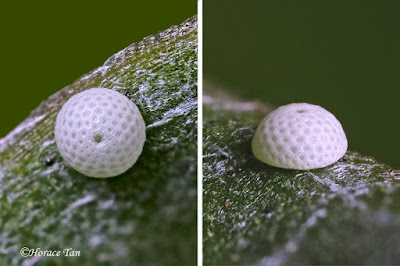The Yellow Palm Dart (Cephrenes trichopepla)
A Yellow Palm Dart perched on the flower of the Feather Cockscomb
The month of April is almost over, but overall, it has been an optimistic month for most of the world's governments who are dealing with the pandemic. It has been more than two and a half years since the dreaded coronavirus descended on the world and covid-fatigue has set in for most communities around the world. Economies and livelihoods have been battered blue-black for many months, and many countries have begun to deal with the virus as an "endemic".
The virus continues to mutate, but the more recent variants, though highly transmissible, have a milder effect on infected individuals, albeit there are still some fatalities. It is the combination of the milder variants, a highly vaccinated population and healthcare systems in place, that Singapore has reverted to a largely pre-covid normalcy. Malls and places of public resort, food and beverage outlets, recreational facilities and so on, are now open without having entrance restrictions.
Other than certain mask-on requirements in enclosed spaces, our environment in Singapore has gone back to almost pre-covid conditions in 2020 before the lock-downs all started. As the citizenry heave a collective sigh of relief, we pick up the pieces and look forward to a world that we were used to. Travel is no longer the luxury of a privileged few, and cross-border forays are now enjoyed by all and sundry.
Over in northern Europe, the Russia-Ukraine war continues unabated, although the invaders still have to contend with a very tenacious and surprisingly determined defence forces of the Ukrainian. As with all wars, it is the civilians and commoners who suffer and this is no different in Ukraine. No one can tell what the outcome will be, or when the invasion will end. But the world is watching and gleaning learning lessons from such an invasion of a sovereign nation by an aggressive neighbour.
Our Butterfly of the Month for April 2022 is a recent addition to the Singapore butterfly fauna - the Yellow Palm Dart (Cephrenes trichopepla). Originally a native to the Australian region, the Yellow Palm Dart was first confirmed recorded in Singapore in 2009 after some years of skepticism that this species actually existed in Singapore. However, records show that it was probably extant in Singapore as early as 1999 when a sighting of this species was reported but not confirmed.
Yellow Palm Darts are often observed perched on the top surfaces of leaves to rest with their wings folded upright
The Yellow Palm Dart is considered a widespread and common species in Singapore today, where it can be found in various habitats from urban gardens to the forested nature reserves and offshore islands. Where its preferred caterpillar host plant can be found - the common coconut palm (Cocos nucifera), this species is often not too far away. It is now found in Malaysia and has also been reported from as far west as Sri Lanka.
The species is swift on the wing, and skittish if disturbed. However, it occasionally perches to rest with its wings opened to sunbathe in the typical skipper fashion. It can sometimes be observed feeding on flowering plants in urban parks and gardens. It is also attracted to bird droppings.
A Yellow Palm Dart perches on the seed pod of a Rattlebox Weed with its wings opened to sunbathe
The Yellow Palm Dart's wings are black above with prominent orange-yellow streaks and spots that are typical of the genera Cephrenes. The orange yellow colour of the post-discal band on the forewing above is continued along the veins towards the termen. The males of this species do not possess a sex brand on the forewing above. The abdomen is orange banded and there is a black patch at the abdominal tip.
A mating pair of the Yellow Palm Dart
On the underside, the colour of the wings are a deep orange-yellow. The post-discal band on the underside of the hindwing is distinctly edged with black, and the band itself is a deeper orange than the surrounding ground colour of the wings. The antennal tips are orange on the inward side of the club, whilst the outer side is black.
The species' caterpillar feeds on various palms, like the Coconut Palm (Cocos nucifera), Livistona sp. (Arecaceae) and Lipstick Palm (Cyrtostachys renda). Given the widespread distribution of the Yellow Palm Dart, it is likely that the caterpillars feed on other species of palms.
Additional Reading : Life History of the Yellow Palm Dart

























































